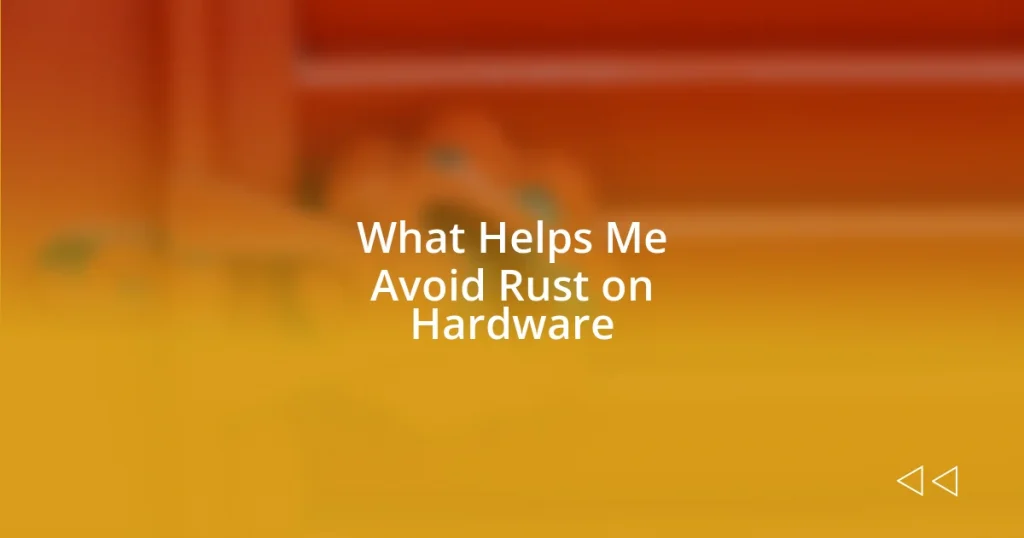Key takeaways:
- Rust results from the chemical reaction between iron, oxygen, and moisture, and can significantly weaken metal tools and structures.
- Common causes of rust include environmental factors (high humidity, rain), damaged protective coatings, and exposure to chemicals.
- Regular maintenance, effective cleaning methods, and the use of protective coatings are essential for preventing and treating rust on hardware.

Understanding Rust on Hardware
Rust is not just an unsightly blemish on metal; it’s a chemical reaction that occurs when iron, oxygen, and moisture come together. I remember the disappointment I felt when I found my favorite garden tools covered in rust after a season of rain. How could something so simple cause such significant damage? This interaction leads to corrosion, which ultimately weakens the metal, reducing its lifespan.
Understanding the specific environments that promote rust can be eye-opening. For instance, I’ve noticed how tools left damp in a humid shed succumb to rust much faster than ones stored in a dry, well-ventilated area. Isn’t it fascinating how easily we can control our surroundings to protect our hardware? Recognizing these factors—like high humidity and exposure to salt—can inform how we maintain our tools and equipment.
It’s interesting to think about how rust isn’t just a problem for tools but also for larger structures, like bridges or cars. A rust stain on my car once sent my heart racing—what if it meant significant repairs? The stakes grow higher when you realize that neglecting rust can lead to safety hazards. This understanding fuels my commitment to preventive measures.

Common Causes of Rust
Rust is often the result of the environment metal is exposed to. I recall my struggle with bike maintenance. Leaving my bike out in the rain just once led to rust on the chain, which was a painful reminder of how quickly moisture can take its toll. That experience taught me to always dry my bike after a ride, especially if it’s rained.
One lesser-known cause is that of poorly applied or damaged protective coatings, like paint. I once had an old set of gardening shears that I thought were well-protected until I noticed a small scratch. That scratch allowed moisture in, and the rust spread quickly. This example reminds me that even small flaws can set off a chain reaction of deterioration.
Lastly, exposure to chemicals can significantly increase the risk of rust. After using certain fertilizers, I left a metal watering can outside without rinsing it off. The result? A patch of rust that formed within days. This incident made me realize the importance of cleaning tools after chemical exposure to prolong their life and keep them in good working order.
| Common Causes of Rust | Examples |
|---|---|
| Environmental Factors | High humidity, rain exposure |
| Damaged Protective Coatings | Scratches or peeling paint |
| Chemical Exposure | Fertilizers, household cleaners |

Effective Rust Prevention Methods
To effectively prevent rust on hardware, I’ve found that routine maintenance is a game-changer. After a particularly frustrating moment when I discovered rust on my favorite gardening gloves’ metal tips, I learned the hard way that keeping tools dry and clean is essential. I now dedicate a few minutes after each use to wipe down my tools and store them in a controlled environment.
Here are some practical methods that have helped me:
- Regular Cleaning: Wipe tools with a dry cloth after each use to remove moisture or dirt.
- Use Rust-Resistant Coatings: Applying a thin layer of oil or rust-inhibiting spray on metal surfaces creates a protective barrier.
- Proper Storage: Keep tools in a dry, ventilated area, avoiding damp and humid environments.
- Embrace Dehumidifiers: In areas prone to high moisture, running a dehumidifier can significantly reduce the risk of rust.
- Utilize Silica Gel Packs: Placing silica gel packs in toolboxes and storage areas absorbs moisture in the air.
In my own experience, investing in a good quality storage solution has paid off. I remember the joy of opening my organized toolbox, where everything was dry and free of rust. It was like finding a little treasure trove of well-preserved tools. Having a reliable way to protect my hardware not only prolongs their life but also gives me peace of mind knowing they are ready for any project.

Importance of Regular Maintenance
Regular maintenance has become indispensable in my toolkit for protecting hardware from rust. I’ve learned that a few minutes spent on upkeep can save a lot of time and money later. For instance, after neglecting to care for my outdoor tools, I confronted a daunting task: removing rust from a once-pristine shovel. It was a frustrating battle, but it turned my focus to the importance of consistent care.
You know how a simple check-up can make all the difference? I remember the sinking feeling I had when I discovered rust creeping up on my garden trowel. It was a sudden reminder of how often I overlooked the small things. A quick rinse and drying could have prevented that moment of dismay. This experience taught me that prevention through regular cleaning and inspections not only keeps tools functioning but also keeps the cheerful spirit of gardening alive.
Moreover, I often think about how my maintained hardware makes my life smoother. Just recently, I reached for my well-cared-for wheelbarrow, gliding through my yard without a hitch. Each chore felt lighter knowing that my tools were ready and rust-free. It made me appreciate the effort I put into maintenance. So, why not take a proactive approach? Regular maintenance creates an environment where my tools thrive, which, in turn, makes every gardening session a joy.

Best Products Against Rust
When it comes to the best products against rust, I’ve had great success with rust-inhibiting sprays. One time, after an unexpected downpour left my bike exposed, I quickly applied a protective spray I had from an earlier project. You wouldn’t believe how much peace of mind came from knowing I had a reliable barrier against rust forming. The right product not only repels moisture but also helps maintain the shiny finish of my bike. Have you ever felt that panic when you realize your outdoor gear isn’t protected? Using a quality rust-inhibiting spray can really turn that anxiety into confidence.
Another standout for me has been using a marine-grade lubricant. I vividly recall a time when I tried to salvage a stubborn hinge on my shed door that had started to rust. I applied the lubricant, and to my surprise, it not only stopped the rust but made the hinge operate smoother than ever. It’s fascinating how a little product can breathe new life into something that seemed beyond help. Have you ever taken a chance on a product and had it exceed your expectations? Finding something effective can truly elevate your experience with maintenance.
Lastly, I can’t overlook the value of natural options like vinegar and baking soda. After experimenting with vinegar on some rusty garden tools, I was ecstatic to see the rust dissolve right before my eyes. It’s moments like these that make maintenance feel less daunting and more like a science experiment. Do you enjoy trying out different methods? Incorporating these natural remedies not only feels satisfying but also reassures me that I’m making a conscientious choice for my tools and the environment.

How to Clean Rust Off
When it comes to cleaning rust off my tools, I’ve found a few methods that really work wonders. Take baking soda, for example. Once, I encountered a rusted old wrench that seemed hopeless. By making a paste with baking soda and water and letting it sit for a while, I was able to scrub the rust away. How satisfying is it to see that shine return? It’s like breathing new life into a forgotten tool.
Another favorite of mine is using white vinegar. I remember my dad swearing by it when I was a kid, and now I get it. I once soaked a rusty pair of pliers in vinegar overnight. The next morning, I was amazed to see how easily the rust came off with just a bit of elbow grease. It feels rewarding to restore something that I thought was beyond repair, doesn’t it? The best part? It’s a straightforward and eco-friendly solution.
For tougher rust, I’ve learned that scrubbing pads work like a charm. I had a particularly stubborn rust stain on my grill that seemed determined to stay put. Armed with a scrubbing pad and some rust remover, I attacked it with vigor. It took a bit of time and effort, but when I finally saw that shiny metal beneath the rust, the sense of victory was unbeatable. Have you ever felt that rush of accomplishment when you conquer a cleaning project? It’s experiences like these that make me appreciate the time spent on maintenance, knowing my efforts lead to a successful outcome.

Long-term Care for Hardware
Caring for hardware over the long term is something I’ve come to appreciate more with each year. I remember my grandfather always saying, “An ounce of prevention is worth a pound of cure.” I took that advice to heart, regularly cleaning and inspecting my tools. There’s something deeply satisfying about discovering a small issue before it turns into a big problem. Have you ever noticed a minor rust spot only to let it slide, and then find it’s become a much larger headache later?
In my experience, consistent maintenance routines are crucial. For instance, I’ve made it a habit to apply a protective layer of lubricant on all metal surfaces every few months. One winter, I skipped this step, thinking my equipment was fine. To my dismay, I found rust starting to creep in on my gardening tools. It was a reminder that neglecting even the simplest tasks can lead to costly repairs. Don’t you love that feeling of knowing you’re being proactive instead of reactive?
Additionally, I’ve learned that proper storage can make a world of difference. I ventured into organizing my garage last summer, only to realize how much humidity my tools were exposed to. After investing in a dehumidifier, I’ve seen a drastic reduction in rust on my hardware. It’s incredible how something as simple as adjusting your environment can enhance the lifespan of your gear, don’t you think? Each step I take to protect my tools feels like an investment in my future projects.















